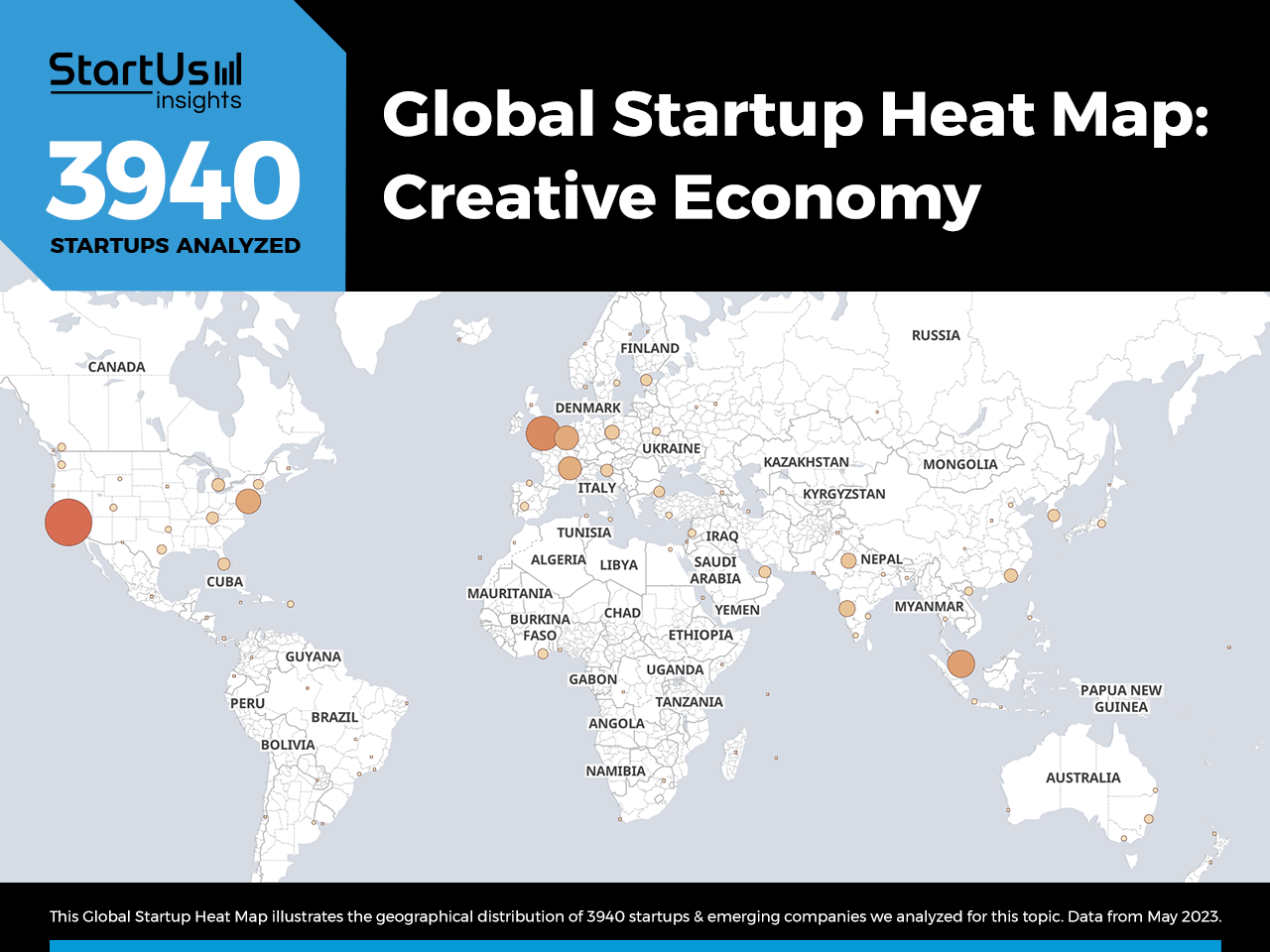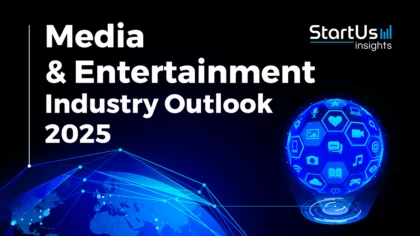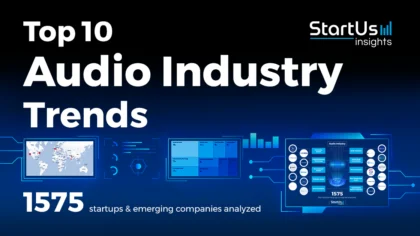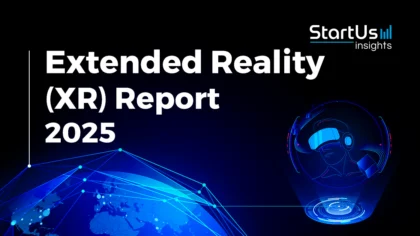Accelerate Productivity in 2025
Reignite Growth Despite the Global Slowdown
The creative economy encounters challenges such as limited funding access, the absence of standardized rights management systems, and difficulties in connecting with audiences. Hence, there is a growing interest in technological solutions to overcome these barriers and unlock the full potential of the industry. Startups are working on various solutions, including non-fungible tokens (NFTs), algorithmic creativity, extended reality (XR), and data analytics. This data-driven research reveals the top 10 trends that shape the future of the creative economy, empowering artists, creators, and businesses to thrive. Read more to explore all trends and how they impact your business.
Innovation Map outlines the Top 10 Creative Economy Trends & 20 Promising Startups
For this in-depth research on the Top Creative Economy Trends & Startups, we analyzed a sample of 3940 global startups & scaleups. This data-driven research provides innovation intelligence that helps you improve strategic decision-making by giving you an overview of emerging technologies in the creative economy industry. In the Creative Economy Innovation Map, you get a comprehensive overview of the innovation trends & startups that impact your company.
These insights are derived by working with our Big Data & Artificial Intelligence-powered StartUs Insights Discovery Platform, covering 3 790 000+ startups & scaleups globally. As the world’s largest resource for data on emerging companies, the SaaS platform enables you to identify relevant technologies and industry trends quickly & exhaustively.
Tree Map reveals the Impact of the Top 10 Creative Economy Trends
Based on the Creative Economy Innovation Map, the Tree Map below illustrates the impact of the Top Creative Economy Trends in 2023. Startups and scaleups are developing NFTs to ensure verifiable authenticity in digital art. Algorithmic creativity leverages AI, especially generative AI, for enriched idea creation. Further, extended reality offers spatial computing and dynamic storytelling for brand owners and gaming businesses. Data analytics solutions optimize decision-making and targeting for cost-effective strategies within marketing teams. Creators also leverage 3D printing helps architecture agencies prototype models faster. Moreover, interactive sensors deliver engaging user experiences, which is valuable for entertainment areas. At the same time, high-speed 5G networks accelerate data processing and streaming for content creators while advertising solutions widen the audience reach. Creative businesses integrate collaboration platforms to facilitate teamwork and communication. Lastly, novel digital rights management (DRM) safeguards intellectual property (IP), enhancing protection within the creative economy.
Top 10 Creative Economy Trends in 2023
- NFT Technology
- Algorithmic Creativity
- Extended Reality
- Data Analytics
- 3D Printing
- Interactive Sensors
- High-speed 5G Networks
- Collaboration Platforms
- AdTech
- Digital Rights Management
Global Startup Heat Map covers 3940 Creative Economy Startups & Scaleups
The Global Startup Heat Map below highlights the global distribution of the 3940 exemplary startups & scaleups that we analyzed for this research. Created through the StartUs Insights Discovery Platform, the Heat Map reveals high startup activity in the US Pacific Coast, followed by the UK and Singapore. Below, you get to meet 20 out of these 3940 promising startups & scaleups as well as the solutions they develop. These creative economy startups are hand-picked based on criteria such as founding year, location, funding raised, & more. Depending on your specific needs, your top picks might look entirely different.
Top 10 Creative Economy Trends in 2023
1. NFT Technology
The ongoing issue of ownership and provenance hinders the efforts of individuals working in the creative industry. Application and integration of Web3 and NFT in digital art allow artists to tokenize their work and establish verifiable authenticity. This enables decentralized ownership, transparent transactions, and smart contract automation. Compared to existing technologies, NFTs provide unique features like indivisibility, programmability, and scarcity. These qualities foster a vibrant ecosystem where creators monetize their work and also engage with their audience. In this way, NFTs promote a more inclusive, sustainable, and protected ecosystem for artists, collectors, and platforms alike.
Metacommerce builds Web3 Ecosystems for Creators
MetaCommerce is a Canadian startup that offers Web3 ecosystems for the creative economy. By leveraging NFT, the startup’s Web3 Studio platform enhances creative processes and facilitates digital communities. With no-code tools, artists easily launch NFT collections, deploy smart contracts, and mint high-quality NFT artworks. Additionally, its decentralized NFT storage ensures the permanence of the products. This technology improves productivity, streamlines workflows, and boosts revenue generation, benefiting both individual creators as well as creative brands, and businesses.
eShot Labs creates an NFT Content Maker
French startup eShot Labs produces NFT assets directly from live video content, including live events, streams, broadcasts, and more. The startup’s Real-time NFT Maker features tailored NFT asset creation, content importation, merging, and white-label customization. This helps creators monetize live events and engage fans more effectively. It also captures and preserves unique moments while providing a marketplace for limited-edition NFTs. As a result, the NFT maker enables new revenue streams, enhanced fan experiences, and broader market access, benefitting creators and event organizers.
2. Algorithmic Creativity
The recent introduction of algorithms presents novel and innovative opportunities for creative processes. Leveraging AI algorithms, machine learning, and generative AI, creators enhance, automate, and expand the boundaries of artistic expression. Recent innovations allow algorithms to learn from vast datasets, analyze patterns, and generate unique outputs that exhibit artistic qualities. This increases efficiency, scalability, and the ability to explore uncharted creative territories. Algorithmic creativity upgrades conventional approaches by providing endless variation, real-time adaptation, and collaboration between virtual and human creators.
Async Art offers Generative AI for Creators
US-based startup Async Art offers a generative AI platform for Web3. With its platform, artists without coding experience create digital interactive artworks and music that evolve over time. The platform generates multiple unique works using rarity percentages, no-code music builder, sales automation, personalized mint pages, and token-gated rights protection. By combining generative AI and blockchain, Async Art resolves the challenge of static and unchanging creations. This technology empowers artists to collaborate, engage with their audience, and monetize their digital artwork while increasing ownership transparency.
Alison.ai develops a Creative Intelligence Platform
Israeli startup Alison.ai makes an AI platform that optimizes ideation and development of creative strategies. Rather than relying on subjective visual appeal, the platform derives data-based insights from key elements such as characters, colors, sounds, text, and more. It navigates data to identify top-performing elements in the content, get full-funnel data, and perform intelligent competitive analysis. Alison.ai enables organizations to pinpoint unique features, identify market opportunities, and produce content that resonates with the audience.
3. Extended Reality
XR solutions open up new immersive experiences in the creative economy. Through technologies like AR, VR, and mixed reality (MR), industries like fashion, marketing, and art are able to deliver interactive and engaging content. XR’s qualities lie in its ability to blend digital and physical worlds, enabling virtual try-ons, interactive advertisements, and immersive art exhibitions. Its other attributes include spatial computing, real-time interactivity, and dynamic storytelling. This provides stakeholders with a broader audience reach, cost reduction, and more engaging narrative techniques.
ZERO10 provides AR-based Fashion Try-On
Cyprus-based startup ZERO10 makes a proprietary fashion AR try-on technology. With advanced features like realistic 3D garment rendering, interactive interface, and accurate body tracking, the startup’s app resolves the problem of limited access to physical fitting rooms and the associated logistical challenges. By leveraging AR mirrors, clients virtually try on clothing and accessories and make informed purchasing decisions. This empowers both consumers and fashion retailers by offering an immersive and convenient shopping experience while reducing returns.
Controlla enables AR Music Gamification
US-based startup Controlla.xyz brings an immersive AR gamified music experience. By combining augmented reality and gamification elements, the startup’s platform enables users to actively engage with music. Through interactive visuals, motion tracking, and gamified challenges, it further enhances traditional song listening and encourages listeners to become active participants. This solution caters to both music enthusiasts and artists, providing an engaging platform for novel creative expression and financial opportunities.
4. Data Analytics
The vast amounts of data present a source of valuable insights into the creative industries. For instance, predictive analytics analyzes data from the past to forecast future trends in marketing and product development. Social media analytics delivers valuable customer behavior insights while big data identifies patterns and trends in large datasets. These innovations optimize decision-making, improve targeting, and increase operational efficiency. As a result, stakeholders achieve financial gains and efficient resource allocation.
Songstats delivers Real-time Music Analytics
Indonesian startup Songstats provides a robust music data analytics platform tailored for Spotify. Its technology assists artists and industry professionals with comprehensive insights into their music’s performance. With features like playlist impact analysis, comprehensive analytics, and demographics view, Songstats understands audience engagement and market trends. As a result, it provides artists, managers, and labels with informed decisions, optimized promotional strategies, and new growth opportunities.
Telescope Labs delivers Gaming Data Insights
UK-based startup Telescope Labs specializes in game AI data analytics. Its platform includes predictive models for proactive game alterations. The platform also features customizable visual dashboards, key performance indicators (KPI) tracking, and user tracking analytics for efficient monitoring and reporting. By harnessing complex gaming data, Telescope Labs simplifies game development processes and ensures player retention. Thus, it benefits game developers, publishers, and stakeholders in driving performance rates and strategic planning for maximized revenue streams.
5. 3D Printing
Prototyping, customization, and testing are critical stages in product development. This greatly improves workflows for engineering firms and consultancies across industries. Emerging solutions in additive manufacturing, like architectural 3D printing, 3D-printed fashion, and more, are revolutionizing the creative industries. Architectural 3D printing enables the construction of complex and sustainable structures while 3D-printed fashion merges technology and design to offer unique and customizable garments. These solutions reduce costs, enhance design flexibility, and enable faster production cycles.
PUNTOZERO utilizes 3D Computational Design
Italian startup Puntozero3D implements advanced 3D computational design solutions leveraging additive manufacturing. The startup’s DfAM technology takes inspiration from lattice structures to design nature-based forms with high topological complexity. With generative design and computational design supported by AI, ML, and cloud computing, the startup realizes intricate geometries. This optimizes development and production costs by minimizing material waste. Further, stakeholders benefit from the flexibility to create complex designs in reduced time to market while improving product performance.
Fixie makes 3D Architecture Models
UK-based startup Fixie3D offers 3D printing solutions, including color jet printing (CJP), selective laser sintering (SLS), and stereolithography (SLA). These technologies excel in speed, volume, and precision, addressing the challenges of rapid prototyping and low-volume production. CJP enables full-color 3D models while SLS and SLA provide high-resolution and durable output. Architectures benefit from fast and accurate production, reduced lead times, and cost-effective manufacturing. Additionally, they explore complex geometries and visualize their creations in vibrant colors, fostering creativity and driving economic growth.

6. Interactive Sensors
Innovations in interactive sensors revolve around the Internet of Things (IoT), haptic feedback systems, and motion-tracking devices. They allow real-time data collection, tactile interactions, and precise movement detection. IoT connects physical objects to the internet, facilitating seamless data exchange and automation. Haptic feedback systems provide users with touch-based sensory experiences, enhancing immersion and realism. Motion tracking devices accurately capture movement and gestures, leading to more intuitive control and interaction. These sensors offer distinct advantages including improved user engagement, enhanced realism, and precise interactivity. As a result, entertainment, marketing, and other areas benefit from enriched user experiences.
Indistinguishable From Magic enables Automated Interactions
US-based startup Indistinguishable From Magic specializes in interactive sensors for art and experiential installations. These sensors enable automated interactions in museums, advertisements, and triggered light shows. With motion, sound, and visitor speed detection, the sensors create captivating experiences based on visitor presence. This technology enhances the engagement and impact of art installations, attracting visitors and providing unique experiences. As a result, it allows artists, museums, and advertisers to foster a deeper connection with art and general industry growth.
VoxelSensors Novel 3D Perception
Belgian startup Voxel Sensors focuses on 3D perception technology utilizing sensor architecture for laser beam scanning. These sensors, equipped with switching pixels technology, work a triangulation system to generate precise 3D data in real time. They provide comprehensive coverage and are immune to interference from concurrent systems. The technology also employs single photon sensitive sensors to enable high temporal resolution and accurate 3D data capture. This low-latent 3D perception allows the creative industry to increase the performance of XR systems and enhance viewer experience.
7. High-speed 5G Networks
The deployment of 5G networks addresses connectivity issues and unlocks entry to the latest advancements. For instance, 5G enables the complete utilization of edge computing nodes to reduce latency and enable real-time data processing. Additionally, 5G facilitates live event streaming in real-time for remote audiences, simulating a physical presence. These solutions need high-speed data transfer and enhanced network capacity, surpassing previous communication methods. Hence, 5G’s heightened efficiency and performance elevate the service level of major platforms, event broadcasters, and other content generators.
Zing establishes 5G Communication Networks
US-based startup Zing offers 5G device technology via wireless fiber connectivity. It delivers low-latency cloud gaming and supports real-time streaming. The technology also features embedded subscriber identity module (eSIM) network authentication for increased flexibility and smart 4K high-definition multimedia interface (HDMI). Additionally, it contains pre-loaded entertainment apps and a digital assistant for hands-free interactions. Zing thus ensures an enriched multimedia experience on large screens through enhanced connectivity, realizing immersive gaming and a user-friendly entertainment ecosystem for content creators and multimedia enthusiasts.
Volvere offers Virtual 5G Internet
Indian startup Volvere Vibe utilizes virtual 5G internet for advanced connectivity with speeds up to 2000 Mbps. Its AIR Studio applies transoceanic cables, modern optical fiber technology, and high-speed virtualization (HVM) to achieve high-speed data transmission and storage. This allows creative businesses to deliver personalized and high-quality content without compromising performance.
8. Collaboration Platforms
Geographical barriers, work sharing, time constraints, and communication obstacles pose limitations to collaborative efforts among creators. To overcome these challenges, startups and scaleups develop cloud collaboration platforms for design, video production, project management, and more. These platforms streamline collaboration, promoting real-time file sharing, effective communication, and efficient workflow management. Design teams further collaborate on projects from various locations, ensuring smooth coordination and version control. Video production teams also edit and review footage remotely, saving time and enhancing productivity. Overall, these cloud collaboration platforms ensure scalability, accessibility, and cost-effectiveness, resulting in improved operational efficiency within the creative economy.
Cloud Media Center develops a Media Distribution Platform
US-based startup Cloud Media Center makes a media distribution platform based on cloud computing. It ensures a consistent flow of high-quality short-form and long-form video content. Further, the platform offers a customized dashboard for each constituency, equipped with real-time analytics. The platform’s solutions improve scalability, feature robust security measures, and ensure efficient media management. This way, content creators, media organizations, and streaming platforms enhance productivity.
Pixso Design Collaboration aids Design Collaboration
Chinese startup Pixso develops a cloud-based design tool that offers a comprehensive solution for digital collaboration. It supports one-click delivery, easy management of design resources, and fosters simplified teamwork. Pixso provides a one-stop platform for prototyping, design, interaction, and delivery of high-fidelity interactive assets. Additionally, the startup allows for real-time synchronization of various design details, such as font size, border, and color. With its intuitive workflow, Pixso improves cross-platform collaboration for designers, digital teams, and professionals.
9. AdTech
Advertising plays a crucial role in boosting exposure, establishing brand awareness, and positioning creative businesses. For instance, programmatic advertising automates ad buying and placement to optimize targeting and audience reach. Personalized targeting utilizes customer analytics to deliver tailored ads to specific demographics. Additionally, dynamic creative optimization tailors ad content in real time based on audience behavior to ensure maximum impact. Further, native advertising integrates promotional content into the user experience to foster authenticity. Influencer marketing allows creative businesses to endorse products and services. These means and solutions benefit diverse creative industries through personalized, data-driven campaigns to boost brand performance.
MagSway Technologies builds an Influencer Marketing Platform
Canadian startup MagSway Technologies provides an influencer marketing and advertising platform. It automatically matches influencers and creators with national and international brands, fostering effective collaborations. The startup’s programmatic ad engine, centralized dashboard, psychological advertising techniques, and AI-backed analytics ensures relevant matches for businesses. These features equip clients with influencer marketing tools that align with brand objectives, driving growth. Moreover, the platform achieves enhanced campaign transparency using blockchain.
Mark Copy offers a Search Engine Optimization (SEO) Platform
French startup MarkCopy develops SEO-optimized writing solutions for content creation. The startup integrates ChatGPT AI to optimize content to make it rank higher in search results. With one-click publishing to WordPress, it streamlines content production, reduces costs, and ensures consistent content quality. Using SEO content brief workflows, the startup also structures content with primary and secondary keywords, style guide adherence, internal linking possibilities, and competitor analysis. To ensure originality, MarkCopy utilizes plagiarism detection and offers increased search traffic and visibility. This improves productivity while promoting the online presence of agencies, brands, and marketing teams.
10. Digital Rights Management
The challenges of safeguarding intellectual property have compelled creative industries to bolster digital rights management (DRM). Some applications include watermarking, content encryption, access control, and digital fingerprinting. Watermarking adds an invisible identifier to creative content for copyright protection. Content encryption secures data during storage and transmission, preventing unauthorized access. Additionally, access control mechanisms restrict user permissions to authorize access to digital assets. Similarly, digital fingerprinting simplifies the identification, monitoring, and tracking of copyrighted materials. These technologies enhance creative industries by safeguarding artists’ rights, preventing piracy, and enabling secure distribution and monetization of digital content.
OneGlimpse ensures Content Protection
Dutch startup OneGlimpse creates a content protection platform. Currently, issues like unpaid work, unauthorized use, sharing management, and design security hinder creative work. To resolve them, the platform offers various tools like screenshot protection, customized sharing options, and encrypted file sharing for protected control over items. It also includes download permissions and the ability to revoke access to artworks, contributing to the safe storage of valuable designs. By leveraging these features, OneGlimpse caters to the needs of design studios, artists, and web developers, providing them with holistic content protection and secured finances.
EzlaScan designs Anti-Piracy Solutions
UK-based startup EzlaScan offers anti-piracy solutions for secure content protection. Through continuous monitoring of major search engines, video platforms, file hosters, and illegal streaming services, it swiftly identifies and reports infringing content. Utilizing advanced search, filter, and validation processes, EzlaScan thoroughly examines entry points to protect digital content. The platform thus maximizes revenue from pirated content and recoups lost monetization streams due to piracy, empowering content creators and rights holders.
Discover all Creative Economy Trends, Technologies & Startups
The exponential rise of technology-driven innovations improves efficiency and content safety for creators. This includes NFT’s influence in the digital art ecosystem and algorithmic creativity driving artistic expression. Additionally, XR, 5G, and interactive sensors are forming alternative ways to engage and build emotional connections with audiences. The future trends will deepen in AI, blockchain, virtual reality, and sustainable practices, further transforming the creative industry. The Creative Economy Trends & Startups outlined in this report only scratch the surface of trends that we identified during our data-driven innovation & startup scouting process. Identifying new opportunities & emerging technologies to implement into your business goes a long way in gaining a competitive advantage.










